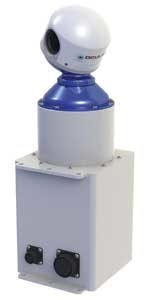MOTION TRACKING: Optical tracking system uses fixed cameras
Target tracking, traffic monitoring, and security and surveillance applications often require following moving objects at high speeds. In many operations, camera systems are fitted onto moving vehicles where they are used to either focus on a fixed target or for continuous 360° monitoring. For applications requiring multidirectional vision, camera systems are often mounted on turntables, pan/tilt systems, or gimbals that are used to change the orientation of the camera. While effective, these mechanical constraints often limit the speed and precision of camera-based tracking systems.
To overcome this,Ocular Robotics (Hurstville, Australia) has developed a vision system known as RobotEye that limits three-dimensional movement to the optical path of the unit while the camera remains fixed (see figure). A video of the system in action can be seen at http://bit.ly/yOdih5.
"The optical path of the RobotEye system consists of an objective located near the physical system aperture followed by an optical element that directs the light down the central axis of the system. This element is always oriented such that for any given azimuth and elevation position of the aperture, signals are always directed down the central axis of the system. Light is then delivered by a relay lens to a C-mount output port to which the desired camera for any particular application can be attached," explains Mark Bishop, founder and CEO of Ocular Robotics.
In operation, only the optical sensing path of the system moves while the camera system itself remains fixed. Like gimbal-based systems, the RobotEye can thus track fast-moving objects by focusing on a fixed point, stabilizing captured images when mounted on a moving vehicle. Unlike gimbal-based systems, however, the camera system is decoupled from the moving platform, which allows a variety of C-mount cameras to be more easily configured. To date, all of the software applications developed for the RobotEye system use the GigE API fromAllied Vision Technologies (AVT; Stadtroda, Germany), which supports AVT's range of GigE Vision-based cameras.
To stabilize images and simultaneously perform tasks such as tracking regardless of the motion of the imaging system requires very fast detection and compensation of any acceleration or pitch, roll, and yaw that may occur. Acceleration and rotational attributes are detected and fed to an inertial measurement unit (IMU) fromInterSense (Billerica, MA, USA). This MEMS-based IMU detects the current rate of acceleration and rotational attributes such as pitch, roll, and yaw using accelerometers and gyroscopes. Once detected, the data are used to stabilize the optical head of the RobotEye system so that, in operation, the RobotEye's optical system can accelerate as fast as 50,000°/s2 with slew speeds up to 10,000°/s.
Typical applications for the RobotEye are ground, air, and marine systems that require stable images to be acquired from vehicles moving quickly over rough terrain or water. However, its high-speed tracking capabilities may be useful for other applications such as in sports broadcasting events where, for example, it may be necessary to track fast-moving objects or people.
Vision Systems Articles Archives

